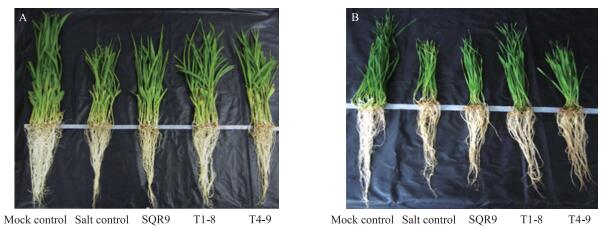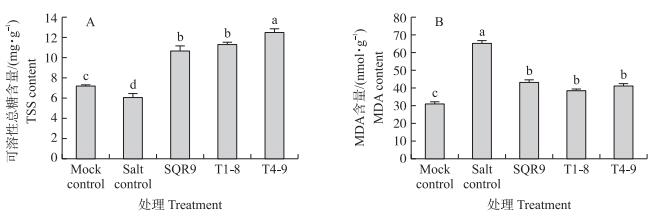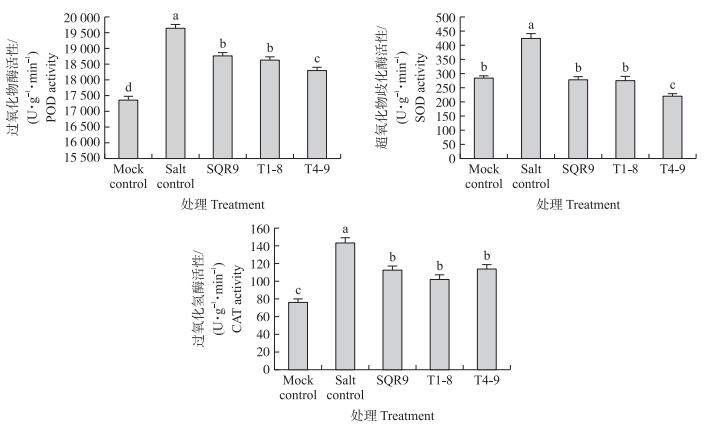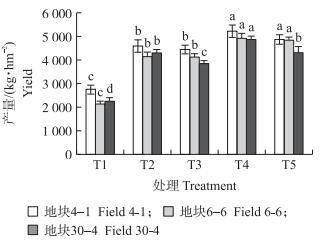文章信息
- 陈小娟, 刘铠鸣, 宣明刚, 邵佳慧, 张瑞福
- CHEN Xiaojuan, LIU Kaiming, XUAN Minggang, SHAO Jiahui, ZHANG Ruifu
- 增强作物耐盐胁迫能力的根际促生菌筛选、鉴定及田间应用效果
- Screening and identification of plant growth-promoting rhizobacteria to enhance salt stress tolerance of crops and their effects in field experiment
- 南京农业大学学报, 2020, 43(3): 452-459
- Journal of Nanjing Agricultural University, 2020, 43(3): 452-459.
- http://dx.doi.org/10.7685/jnau.201905003
-
文章历史
- 收稿日期: 2019-05-04
我国盐碱地总面积为9 913万hm2, 约占全世界盐碱地总面积的10%[1]。土壤盐渍化给农业生产带来极大的障碍。我国人口众多, 粮食需求日益高涨而耕地资源紧张, 合理利用盐碱地提高粮食生产对保障我国粮食安全需求具有重要意义。
植物根际促生菌(plant growth-promoting rhizobacteria, PGPR)是一类定殖于植物根际、对植物生长和健康发挥有益作用的微生物[2-3]。根际微生物群落多样性高, 代谢旺盛[4], 可以利用植物根系分泌物生长, 定殖于植物根际和植物长期互惠共存[5-6]。PGPR可以通过增强根际养分的可利用性[7]、产生挥发性促生物质[8]、调节植物激素水平[9]等促进植物生长。在面临生物胁迫时, PGPR可通过分泌次生代谢物质(如脂肽类和聚酮类化合物、抗生素、细菌素和水解酶等)拮抗病原菌[10], 也可通过营养竞争抑制病原菌的生长[11]; PGPR还可以诱导植物产生系统抗性抵抗病原细菌、真菌、病毒和线虫等侵染。在非生物胁迫条件下, PGPR能够通过调节植物乙烯合成速度缓解盐碱、干旱、水涝、温度等胁迫[12]。
微生物肥料能够改良土壤性状, 提高土壤肥力, 促进植物对营养元素吸收, 增强作物抗逆性, 调节植物生长, 提升农产品质量及产量[13], 在化肥减施增效、农业绿色发展中发挥重要的作用。生物有机肥能增强盐碱胁迫下一些经济作物如棉花[14]、向日葵[15]、苜蓿[16]等的生长, 但是对促进盐碱地主要粮食作物增产的微生物肥料的研究和应用仍较少。本研究立足于筛选具有增强主要粮食作物耐盐胁迫能力的根际促生菌, 研制盐碱地粮食增产的专用微生物肥料, 为盐碱地高效利用和农业增产提供保障。
1 材料与方法 1.1 材料 1.1.1 盐碱地根际土壤样品采集盐碱地土壤分别为:浙江省绍兴市上虞区沥海镇沿海滩涂玉米土, 山东省滨州市无棣县试验基地玉米土, 江苏省海门市新勇村玉米土、油菜土, 江苏省南通市通州区二甲镇油菜土及滨海园区玉米土, 江苏省海门市头桥村小麦土、水稻土、油菜土。共采集9种滨海盐碱地的非盐生植物根际土壤样品, 采回的土壤样品分别置于盆钵中, 调节含水量至田间最大持水量的60%左右, 培育待用。
1.1.2 根际微生物培养基根际微生物分离筛选培养基(LB培养基):蛋白胨10 g, 氯化钠10 g, 酵母粉5 g, 蒸馏水定容至1 L, pH7.0。
根际微生物促生能力检测培养基(NBRIP培养基)[17]; 植酸酶固体培养基[18]; CAS蓝色检测液[19]; MS培养基[20]。
微生物肥料液体发酵培养基原料及试剂:糖蜜(广西柳州金黔湾糖蜜有限公司生产)为碳源; 氮源为豆粕粉、蛋白胨、硫酸铵; 无机盐为氯化钠、磷酸二氢钾、氯化钙、硫酸镁、硫酸亚铁、硫酸锌、硫酸锰。
1.1.3 微生物肥料菌种解淀粉芽胞杆菌SQR9, 由南京农业大学资源与环境学院植物营养系有机肥团队即江苏省固体废弃物资源化利用高技术研究重点实验室分离鉴定, 该菌株具有一定增强植物耐盐胁迫能力, 以此菌株作为筛选新菌种的参照菌株[21]。其他功能菌株由盐碱地根际土壤样品分离获得。
1.1.4 微生物肥料有机肥载体腐熟堆肥购于江阴市联业生物科技有限公司, 为腐熟后的牛粪猪粪秸秆混合堆肥, 其中全氮含量为10.56 g · kg-1, 全磷含量为25.21 g · kg-1, 全钾含量为13.22 g · kg-1, 有机质含量为485.10 g · kg-1。
1.1.5 供试作物盆栽试验供试作物:玉米品种为‘京甜紫花糯’, 小麦品种为‘百农矮抗58’; 小区试验供试玉米品种为‘恒源1号’。
1.2 方法 1.2.1 功能菌株筛选分别从9个土壤样品中称取5 g土样置于250 mL锥形瓶(锥形瓶中预先盛有无菌玻璃珠和100 mL无菌去离子水)中, 35 ℃、170 r · min-1振荡30 min, 得到土壤悬液。再分别将每种土壤悬液10倍梯度稀释, 选择稀释梯度为10-3、10-4、10-5、10-6的土壤稀释悬液, 将不同梯度的每种土壤稀释液加入2 mL无菌离心管中, 置于泡沫悬浮器上90 ℃水浴15 min, 冷却后取100 μL土壤稀释液在LB平板上涂布, 35 ℃倒置培养12 h, 选取生长迅速、形态不同的单菌落, 将每个单菌落的菌株经LB平板划线纯化3次, 分别置于终浓度为30%(体积分数)灭菌甘油管中并编号, 于-80 ℃保藏待用。
将玉米和小麦种子表面消毒(75%乙醇浸泡1 min, 3%次氯酸钠浸泡5 min, 无菌水冲洗5~6次)后发苗7 d, 然后将玉米、小麦幼苗分别置于NaCl浓度为140 mmol · L-1(玉米)和180 mmol · L-1(小麦)的1/4 MS营养液中, 根际接种终浓度为107 CFU · mL-1无菌水重悬的菌株(分离的根际芽胞杆菌), 以没有盐胁迫不接菌处理作为空白对照(mock control), 盐胁迫下不接菌处理作为盐处理对照(salt control), 解淀粉芽胞杆菌SQR9作为参照菌种(SQR9)。培养14 d后测定玉米和小麦植株的株高和地上部鲜质量以及玉米叶片各项与盐胁迫相关的指标, 如可溶性总糖(TSS)、丙二醛(MDA)、全钾(K+)和全钠(Na+)含量, 以及过氧化物酶(POD)、超氧化物歧化酶(SOD)和过氧化氢酶(CAT)活性。测定结果显著优于参照菌株SQR9的芽胞杆菌, 即为初筛菌株。
1.2.2 菌株促生特性鉴定参照Dye[22]和康贻军等[23]的方法测定NH3产生能力; 参照Schwyn等[19]和林天兴等[24]的方法测定嗜铁素产生能力; 参照Glickmann等[25]的方法测定吲哚乙酸(IAA)产生能力; 参照文献[26-28]的方法测定溶磷能力。
1.2.3 菌株鉴定待测各菌株在LB液体培养基中培养至对数期, 采用SDS-CTAB法提取总基因组DNA, 采用通用引物27F/1492R[29](正向引物:5′-AGAGTTTGATCCTGGCTCAG-3′; 反向引物:5′-GGTTACCTTGTTACGACTT-3′)进行16S rDNA基因扩增, 测序结果在RDP数据库中进行比对, 并构建发育树以确定菌株的分类。
1.2.4 微生物有机肥制备将菌株SQR9、T1-8和T4-9在改良的糖蜜培养基中进行液体发酵, 之后分别与有机物料(牛粪、猪粪、秸秆混合堆肥)均匀混合后进行二次固体发酵, 中途进行翻堆, 使其发酵温度低于50 ℃, 发酵7 d, 获得二次固体发酵的微生物有机肥, 所含活菌或芽胞量达到108CFU · g-1以上, 其他性质与所用有机肥基本相同。
1.2.5 微生物有机肥田间小区试验选择山东省无棣县渤海粮仓无棣样板示范项目区(N37°46′9.57″, E117°37′11.31″)3个盐碱地块, 分别为4区1号(4-1)地块、6区6号(6-6)地块以及30区4号(30-4)地块。土壤基本理化性质见表 1。
| 试验地 Experimental |
有机质含量/ g·kg-1 Organic matter content |
全氮含量/ g·kg-1 Total phosphorus content |
全磷含量/ g·kg-1 Total phosphorus |
全钾含量/ g·kg-1 Total potassium content |
阴离子交换量/ g·kg-1 CEC |
氯离子含量/ mg·kg-1 Chloride ion content |
pH值 pH value |
盐含量/ g·L-1 Salt content |
| 地块4-1 Field 4-1 |
17.828±0.173a | 1.23±0.032a | 0.981±0.012a | 24.754±0.086a | 5.303±0.219a | 36.636±0.524a | 7.8±0.1b | 3.12±0.49b |
| 地块6-6 Field 6-6 |
8.175±0.216b | 0.62±0.271b | 0.729±0.034b | 20.243±0.165b | 2.595±0.231b | 32.846±0.144b | 8.1±0.1a | 4.45±0.43a |
| 地块30-4 Field 30-4 |
3.156±0.144c | 0.42±0.102c | 0.461±0.026c | 20.333±0.071b | 0.976±0.162c | 29.190±0.421c | 8.4±0.2a | 5.37±0.52a |
| 不同字母表示差异显著(Duncan’s-test, P < 0.05)。 Note:Different letters represent significant differences(Duncan ' s-test, P < 0.05). |
||||||||
3个地块分别设置3组小区试验, 每个地块的小区试验处理分别为:T1, 不施肥处理(CK); T2, 常规施化肥处理; T3, 3 000 kg · hm-2的普通有机肥替代部分化肥处理; T4, 3 000 kg · hm-2的T1-8生物有机肥替代部分化肥处理; T5, 3 000 kg · hm-2的T4-9生物有机肥替代部分化肥处理。每个地块每个处理设置3个重复, 随机区组排列, 以T1处理的养分为土壤背景值, 其余处理总养分保持一致, 播种后的玉米于自然环境下生长, 除基肥外的其他田间管理均一致。
小区试验时间为2018年6—10月, 小区总面积2 881 m2, 每个小区面积为64 m2。
1.2.6 田间试验样品采集与分析2018年9月上旬, 玉米处于大喇叭口期, 分别测定玉米行距、株距, 每个小区随机采取玉米植株12株, 编号贴标签, 当场测定株高、茎粗和地上部鲜质量。2018年10月, 玉米处于收获期, 每个小区随机各取3个样点, 每个样点用卷尺量3 m区域, 统计卷尺两边玉米株数和玉米成穗数; 在每个统计样段内每隔5穗收取1穗玉米, 共计收获20穗作为样品测定穗粒数和百粒质量, 并计算产量。
1.3 数据处理与分析数据处理采用Excel 2010, 统计分析采用SPSS BASE ver.19.5软件中单因素方差分析方法。
2 结果与分析 2.1 增强植物耐盐胁迫能力根际促生菌的分离初筛得到127株能在固体LB培养基上快速生长的菌株, 将纯化的菌株保存于-80 ℃, 利用玉米和小麦的水培盆栽试验获得明显增强作物耐盐能力的菌株T1-8和T4-9, 分别筛选自江苏省南通市通州滨海园区土和浙江省上虞沿海滩涂玉米土。在玉米盐浓度为140 mmol · L-1、小麦盐浓度为180 mmol · L-1的情况下, 菌株T1-8和T4-9处理后的株高和地上部鲜质量均显著高于对照(表 2)。空白对照(mock control)组的玉米和小麦生长明显优于其他处理, 菌株T1-8和T4-9及参照菌株SQR9处理植物均比未接种盐处理对照(salt control)长势好(图 1)。在小麦盆栽试验中, 与空白对照相比, 接种菌株T1-8显著提高小麦鲜质量。
| 作物Crop | 处理Treatments | 株高/cmShoot height | 地上部鲜质量/g Shoot fresh weight |
| 玉米 | Mock control | 42.32±2.13a | 2.65±0.16a |
| Maize | Salt control | 28.11±3.12c | 1.27±0.15d |
| SQR9 | 31.14±2.71bc | 1.62±0.13c | |
| T1-8 | 35.27±3.07b | 1.97±0.12b | |
| T4-9 | 34.88±2.66b | 1.75±0.11bc | |
| 小麦 | Mock control | 26.81±2.36a | 0.39±0.05a |
| Wheat | Salt control | 17.35±1.78c | 0.21±0.03c |
| SQR9 | 19.26±2.61bc | 0.23±0.02c | |
| T1-8 | 23.52±2.71b | 0.30±0.04ab | |
| T4-9 | 22.67±1.66b | 0.28±0.02b | |
| 注: 1)不同小写字母表示同一作物不同处理间差异显著(P < 0.05)。 2) Mock control:无盐和接菌处理; Salt control:NaCl处理(玉米140 mmol · L-1, 小麦180 mmol · L-1); SQR9:NaCl处理后根际接种菌株SQR9;T1-8:NaCl处理后根际接种菌株T1-8;T4-9:NaCl处理后根际接种菌株T4-9。下同。 Note: 1)Different lowercase letters indicate significant differences among different treatments of the same crop(P < 0.05). 2) Mock control:No salt and strain inoculation; Salt control:NaCl treatment(maize 140 mmol · L-1, wheat 180 mmol · L-1); SQR9:NaCl treatment with inoculation of strain SQR9;T1-8:NaCl treatment with inoculation of strain T1-8;T4-9:NaCl treatment with inoculation of strain T4-9. The same as follows. |
|||

|
图 1 不同处理的玉米(A)和小麦(B)生长情况 Fig. 1 Maize(A)and wheat(B)growth under different treatments |
将菌株T1-8和T4-9的16S rDNA基因序列构建系统发育树, 初步鉴定2株菌均属于芽胞杆菌属(Bacillus sp.)(图 2), 菌株T1-8鉴定为副地衣芽胞杆菌(中国普通微生物菌种保藏管理中心专利保藏编号:CGMCC17335), 菌株T4-9为巨大芽胞杆菌(中国普通微生物菌种保藏管理中心专利保藏编号:CGMCC17334)。

|
图 2 基于菌株T1-8和T4-9的16S rDNA基因序列构建的系统发育树 Fig. 2 Phylogenetic tree construction based on 16S rDNA gene sequences of strains T1-8 and T4-9 |
菌株T1-8和T4-9均具有一定的产氨、产嗜铁素、产IAA及溶解无机磷的能力, 其中菌株T4-9产生吲哚乙酸能力较强, 达到60.82 mg · L-1(表 3)。
| 菌株编号 Strain code |
产氨 NH3 production |
铁载体 Siderophore production |
吲哚乙酸产量/(mg·L-1) IAA production |
溶磷量/(mg·L-1) Soluble phosphate |
| T1-8 | + | + | 10.89±0.57 | 0.281 1±0.003 1 |
| T4-9 | + | +++ | 60.82±0.80 | 0.253 7±0.002 1 |
| 注:从“+++”到“+”表示产氨能力和产铁载体能力由强到弱。 Note:From"+++"to"+"represent different amount of ammonia and siderophore production from strong to weak. |
||||
玉米植株处于140 mmol · L-1 NaCl环境下并未增加体内的可溶性总糖(TSS)含量, 而是降低TSS含量, 140 mmol · L-1 NaCl盐胁迫下接菌处理的玉米叶片TSS含量显著高于对照组(图 3-A)。与无盐对照相比, 其他处理玉米叶片MDA含量均显著升高, 接菌处理MDA含量比盐胁迫处理显著降低。说明接菌可以缓解玉米细胞膜脂过氧化程度, 从而减轻盐胁迫对玉米植株的伤害(图 3-B)。

|
图 3 不同处理玉米叶片中的可溶性总糖(A)和MDA(B)含量 Fig. 3 Soluble total sugar(TSS)(A)and MDA(B)contents in maize leaves of different treatments 不同小写字母表示处理间差异显著(P<0.05)。下同。 Different lowercase letters represent significant differences in different treatments(P<0.05). The same as follows. |
植物的抗氧化体系包括酶促体系和非酶促体系, 其中过氧化物酶(POD)、超氧化物歧化酶(SOD)和过氧化氢酶(CAT)属于酶促抗氧化酶。与无盐对照相比, 盐处理对照组POD、SOD和CAT活性均显著增强。SQR9、T1-8和T4-9处理均显著降低玉米叶片中POD、SOD和CAT活性(图 4)。

|
图 4 不同处理玉米叶片中的过氧化物酶、超氧化物歧化酶和过氧化氢酶活性 Fig. 4 Activities of peroxidase(POD), superoxide dismutase(SOD)and catalase(CAT) in maize leaves of different treatments |
与无盐对照相比, 所有盐处理组玉米叶片中全钾含量均显著降低, 而全钠含量均显著增加(图 5)。在接种菌株T1-8和T4-9之后, 玉米通过增加体内K+减少Na+从而减轻离子毒害。

|
图 5 不同处理玉米叶片中的全钾和全钠含量 Fig. 5 Contents of total potassium and sodium in maize leaves of different treatments |
由图 6可知:不施肥处理(T1)的玉米产量显著低于各施肥处理组, 施用化肥(T2)和普通有机肥(T3)处理的玉米产量没有显著差异。施用含菌株T1-8和T4-9的微生物有机肥对3种不同盐碱程度地块的玉米均有显著的增产作用, 其中施加T1-8菌肥(T4)处理在含盐量为5 g ·L-1地块效果最佳, 产量增加1 026.2 kg · hm-2, 增幅为26.70%;施加T4-9菌肥(T5)处理在含盐量为4 g ·L-1地块效果最佳, 产量增加703.6 kg · hm-2, 增幅为17.04%。大田试验结果说明, 施用含菌株T1-8和T4-9的微生物有机肥可以显著增加盐碱地玉米的产量。

|
图 6 大田试验不同施肥处理玉米产量 Fig. 6 Maize yields of different fertilization treatments in the field experiment T1:不施肥处理; T2:化肥; T3:普通有机肥; T4:T1-8微生物有机肥; T5:T4-9微生物有机肥。 T1:No fertilizer; T2:Chemical fertilizer; T3:Organic fertilizer; T4:T1-8 microbial organic fertilizer; T5:T4-9 microbial organic fertilizer. |
近年来, 土壤盐渍化程度日趋严重, 盐碱地有效利用迫在眉睫。微生物肥料对植物的促生作用研究较早, 但增强作物耐盐生长的新型功能微生物肥料发展较晚。微生物肥料具有改良土壤、增加产量、提高品质和保护环境等优点[30], 微生物肥料产业发展快速[31]。优良的植物根际促生菌是微生物肥料的基础, 其诱导植物抵抗盐碱胁迫的机制, 主要为产生植物激素、ACC脱氨酶、抗氧化防御物质、渗透调节物质、胞外多糖和挥发性气体等生理活性物质, 实现改变植物生理及物质代谢水平的目标[32]。盐胁迫环境下, 接种菌株T1-8和T4-9后, 玉米植株中渗透调节物质TSS含量增加, 以维持玉米的渗透压; MDA含量降低, 减轻细胞膜质过氧化程度; POD活性降低, 延缓玉米组织老化程度。通过上述物质作用, 接种菌株T1-8和T4-9可以缓解玉米的盐害, 增强玉米对盐胁迫耐受能力。
改良剂与微生物菌剂的联合施用能降低盐碱土的全盐含量, 同时还能培肥土壤, 增加末期土壤的有机质和有效磷含量[32]。黄铖程[33]研究表明, 与使用化肥的处理相比, 生物菌肥与化肥混施处理的燕麦、箭筈豌豆的产量分别增加4.00%和8.40%, 结果证明生物菌肥能在一定程度上改善土壤理化性质, 促进作物生长。本研究的微生物有机肥田间试验结果表明, 施用含菌株T1-8和T4-9的微生物有机肥能显著增加盐碱地玉米的产量, 最大增幅分别达到26.70%和17.04%, 可以将其作为盐碱地专用微生物有机肥应用。
| [1] |
王遵亲, 祝寿泉, 俞仁培, 等. 中国盐渍土[M]. 北京: 科学出版社, 1993. Wang Z Q, Zhu S Q, Yu R P, et al. Saline Soil in China[M]. Beijing: Science Press, 1993 (in Chinese). |
| [2] | |
| [3] |
Glick B R. Plant growth-promoting bacteria:mechanisms and applications[J]. Scientifica, 2012, 2012: 1-15. |
| [4] |
Weller D M, Thomashow L S. Current challenges in introducing beneficial microorganisms into the rhizosphere[M]//Molecular Ecology of Rhizosphere Microorganisms. Weinheim, Germany:Wiley-VCH Verlag GmbH, 2007:1-18.
|
| [5] |
Benizri E, Baudoin E, Guckert A. Root colonization by inoculated plant growth-promoting rhizobacteria[J]. Biocontrol Science and Technology, 2001, 11(5): 557-574. DOI:10.1080/09583150120076120 |
| [6] |
Bais H P, Weir T L, Perry L G, et al. The role of root exudates in rhizosphere interactions with plants and other organisms[J]. Annual Review of Plant Biology, 2006, 57(1): 233-266. DOI:10.1146/annurev.arplant.57.032905.105159 |
| [7] |
Canbolat M Y, Bilen S, Çakmakçı R, et al. Effect of plant growth-promoting bacteria and soil compaction on barley seedling growth, nutrient uptake, soil properties and rhizosphere microflora[J]. Biology and Fertility of Soils, 2006, 42(4): 350-357. DOI:10.1007/s00374-005-0034-9 |
| [8] |
Bhattacharyya P N, Jha D K. Plant growth-promoting rhizobacteria(PGPR):emergence in agriculture[J]. World Journal of Microbiology and Biotechnology, 2012, 28(4): 1327-1350. |
| [9] |
Bhardwaj D, Ansari M, Sahoo R, et al. Biofertilizers function as key player in sustainable agriculture by improving soil fertility, plant tolerance and crop productivity[J]. Microbial Cell Factories, 2014, 13(1): 66. DOI:10.1186/1475-2859-13-66 |
| [10] |
Butcher R A, Schroeder F C, Fischbach M A, et al. The identification of bacillaene, the product of the PksX megacomplex in Bacillus subtilis[J]. Proc Natl Acad Sci USA, 2007, 104(5): 1506-1509. DOI:10.1073/pnas.0610503104 |
| [11] |
Sharapov V M, Kalvish T K. Effect of soil fungistasis on zoopathogenic fungi[J]. Mycopathologia, 1984, 85(1/2): 121-128. |
| [12] |
Lee S W, Lee S H, Balaraju K, et al. Growth promotion and induced disease suppression of four vegetable crops by a selected plant growth-promoting rhizobacteria(PGPR)strain Bacillus subtilis 21-1 under two different soil conditions[J]. Acta Physiologiae Plantarum, 2014, 36(6): 1353-1362. |
| [13] |
李庆康, 张永春, 杨其飞, 等. 生物有机肥肥效机理及应用前景展望[J]. 中国生态农业学报, 2003, 11(2): 78-80. Li Q K, Zhang Y C, Yang Q F, et al. The concept, mechanism, affecting factors and prospect of applying bio-organic fertilizer[J]. Chinese Journal of Eco-Agriculture, 2003, 11(2): 78-80 (in Chinese with English abstract). |
| [14] |
胡高峰, 张小勇, 莫海涛, 等. 抗盐碱制剂对棉花幼苗生理生化特性的影响[J]. 西北农业学报, 2009, 18(2): 169-172. Hu G F, Zhang X Y, Mo H T, et al. The effects of resistance salt-alkaline preparation on the characters of physiological and biochemical index of cotton seedling[J]. Acta Agriculturae Boreali-Occidentalis Sinica, 2009, 18(2): 169-172 (in Chinese with English abstract). DOI:10.3969/j.issn.1004-1389.2009.02.037 |
| [15] |
王善仙, 刘宛, 李培军, 等. 生物有机肥调控对盐碱胁迫下向日葵幼苗生长及生理指标的影响[J]. 生态学杂志, 2011, 30(4): 682-688. Wang S X, Liu W, Li P J, et al. Regulation effects of bioorganic fertilizer on sunflower seedlings growth and leaf physiological indices under salt-alkali stress[J]. Chinese Journal of Ecology, 2011, 30(4): 682-688 (in Chinese with English abstract). |
| [16] |
张金柱. 生物有机肥对盐碱土理化性质及苜蓿生理反应影响的研究[J]. 哈尔滨:东北农业大学, 2007. Zhang J Z. Effect of microbial organic fertilizer on physicochemical property of saline alkali soil and physiologic reaction of alfalfa[J]. Harbin:Northeast Agricultural University, 2007 (in Chinese with English abstract). |
| [17] |
朱培淼, 杨兴明, 徐阳春, 等. 高效解磷细菌的筛选及其对玉米苗期生长的促进作用[J]. 应用生态学报, 2007, 18(1): 107-112. Zhu P M, Yang X M, Xu Y C, et al. High effective phosphate-solubilizing bacteria:their isolation and promoting effect on corn seedling growth[J]. Chinese Journal of Applied Ecology, 2007, 18(1): 107-112 (in Chinese with English abstract). DOI:10.3321/j.issn:1001-9332.2007.01.018 |
| [18] |
Howson S J, Davis R P. Production of phytate-hydrolysing enzyme by some fungi[J]. Enzyme and Microbial Technology, 1983, 5(5): 377-382. DOI:10.1016/0141-0229(83)90012-1 |
| [19] |
Schwyn B, Neilands J B. Universal chemical assay for the detection and determination of siderophores[J]. Analytical Biochemistry, 1987, 160(1): 47-56. |
| [20] |
Murashige T, Skoog F. A revised medium for rapid growth and bio assays with tobacco tissue cultures[J]. Physiologia Plantarum, 1962, 15(3): 473-497. |
| [21] |
陈淋. 解淀粉芽孢杆菌SQR9增强植物耐盐能力的机制研究[J]. 南京:南京农业大学, 2016. Chen L. Mechanism of enhanced plant salt tolerance by Bacillus amyloliquefaciens SQR9[J]. Nanjing:Nanjing Agricultural University, 2016 (in Chinese with English abstract). |
| [22] |
Dye D W. The inadequacy of the usual determinative tests for the identification of Xanthomonas spp[J]. New Zealand Journal of Science, 1962, 5(4): 393-416. |
| [23] |
康贻军, 程洁, 梅丽娟, 等. 植物根际促生菌作用机制研究进展[J]. 应用生态学报, 2010, 21(1): 232-238. Kang Y J, Cheng J, Mei L J, et al. Action mechanisms of plant growth-promoting rhizobacteria(PGPR):a review[J]. Chinese Journal of Applied Ecology, 2010, 21(1): 232-238 (in Chinese with English abstract). |
| [24] |
林天兴, 唐梅, 黄明远, 等. 高产铁载体棉田土壤细菌SS05的筛选与鉴定[J]. 微生物学通报, 2012, 39(5): 668-676. Lin T X, Tang M, Huang M Y, et al. Screening and identification of a high yield sideropho-resproducing bacteria SS05 isolated from cotton soil[J]. Microbiology China, 2012, 39(5): 668-676 (in Chinese with English abstract). |
| [25] |
Glickmann E, Dessaux Y. A critical examination of the specificity of the salkowski reagent for indolic compounds produced by phytopathogenic bacteria[J]. Applied and Environmental Microbiology, 1995, 61(2): 793-796. |
| [26] |
Son H J, Park G T, Cha M S, et al. Solubilization of insoluble inorganic phosphates by a novel salt- and pH-tolerant Pantoea agglomerans R-42 isolated from soybean rhizosphere[J]. Bioresource Technology, 2006, 97(2): 204-210. DOI:10.1016/j.biortech.2005.02.021 |
| [27] |
康贻军, 胡健, 单君, 等. 两株解磷真菌的解磷能力及其解磷机理的初步研究[J]. 微生物学通报, 2006, 33(5): 22-27. Kang Y J, Hu J, Shan J, et al. Solubilization capacity of insoluble phosphates and its mechanismby two phosphate solubilizing fungi(PSF)[J]. Microbiology China, 2006, 33(5): 22-27 (in Chinese with English abstract). DOI:10.3969/j.issn.0253-2654.2006.05.005 |
| [28] |
李引, 虞丽, 李辉信, 等. 一株花生根际促生菌的筛选鉴定及其特性研究[J]. 生态与农村环境学报, 2012, 28(4): 416-421. Li Y, Yu L, Li H X, et al. Isolation, identification and characteristics of a peanut growth-promoting strain of rhizobacteria[J]. Journal of Ecology and Rural Environment, 2012, 28(4): 416-421 (in Chinese with English abstract). DOI:10.3969/j.issn.1673-4831.2012.04.015 |
| [29] |
Kumar S, Stecher G, Tamura K. MEGA7:molecular evolutionary genetics analysis version 7[J]. Molecular Biology and Evolution, 2016, 33(7): 1870-1874. DOI:10.1093/molbev/msw054 |
| [30] |
刘军辉, 李利. 我国微生物肥的应用研究进展[J]. 河北果树, 2018(5): 5-6. Liu J H, Li L. Research advances on application of microbial fertilizers in China[J]. Hebei Fruits, 2018(5): 5-6 (in Chinese). |
| [31] |
姜焕焕, 王通, 陈娜, 等. 根际促生菌提高植物抗盐碱性的研究进展[J]. 生物技术通报, 2019(10): 189-197. Jiang H H, Wang T, Chen N, et al. Research progress in PGPR improving plant's resistance to salt and alkali[J]. Biotechnology Bulletin, 2019(10): 189-197 (in Chinese with English abstract). |
| [32] |
汪立梅, 桂丕, 李化山, 等. 改良剂与微生物菌剂联合施用对盐碱地土壤和耐盐植物的影响[J]. 江苏农业科学, 2018, 46(17): 264-269. Wang L M, Gui P, Li H S, et al. Effects of combined application of improver and microbial agents on saline-alkali soil and salt-tolerant plants[J]. Jiangsu Agricultural Sciences, 2018, 46(17): 264-269 (in Chinese with English abstract). |
| [33] |
黄铖程. 复合微生物菌肥对盐碱地燕麦与箭筈豌豆生理特性及土壤速效养分的影响[J]. 呼和浩特:内蒙古农业大学, 2018. Huang C C. The effect of the compound microbial fertilizer on the physiological characteristics of oats and Vicia sativa and soil available nutrient in saline-alkali land[J]. Hohhot:Inner Mongolia Agricultural University, 2018 (in Chinese with English abstract). |




